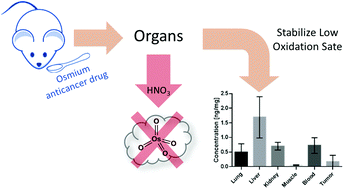Post-digestion stabilization of osmium enables quantification by ICP-MS in cell culture and tissue
Abstract
An orally active osmium anticancer compound was reliably quantified in the organs of treated mice by inductively coupled plasma-mass spectrometry (ICP-MS) by adding a stabilizing solution consisting of ascorbic acid, thiourea and EDTA during sample preparation and avoiding oxidizing conditions. The limits of detection (LOD) and quantification (LOQ) of 189Os were determined in liver tissue to be 0.02 and 0.075 μg kg−1, respectively. In spiked liver tissue, the internal precision showed a relative standard deviation (RSD) of 4%, a matrix recovery of 92% and a digestion recovery of 99%. A similar quantification protocol was developed for cellular accumulation studies in vitro. The cells were lysed with a non-oxidizing lysis buffer consisting of 150 mmol L−1 NaCl, 1.0% Triton X-100, 0.1% SDS, and 50 mmol L−1 Tris at pH 8.0 before adding the stabilizing solution. The osmium compound was compared with an isosteric ruthenium analogue and they displayed similar cellular accumulation and organ distribution profiles.



 Please wait while we load your content...
Please wait while we load your content...